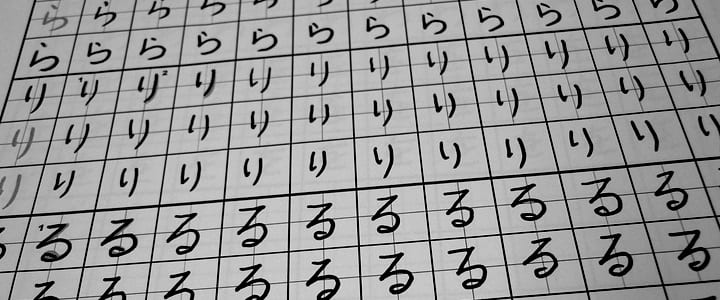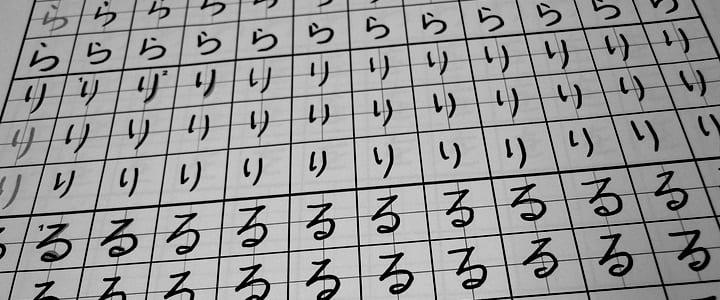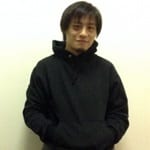
With three different writing systems, learning Japanese can be confusing for beginners. It’s much easier to break the systems down, and focus on one at a time. Here, Japanese teacher Kaoru N. shares his tips to help you learn hiragana…
There are three types of letters in the Japanese language: hiragana, katakana, and kanji. Hiragana and katakana are based on sounds and pronunciation. In kanji, each character has its own meaning.
Hiragana characters are the most fundamental and basic characters among the three types of Japanese letters. Hiragana letters were derived from kanji, and kanji originated from the Han Dynasty in China.
If you want to learn hiragana, it’s important to understand some basic rules about the writing system. Here is a general breakdown and some study tips to help you learn hiragana.
46 Hiragana Symbols
If you want to learn enough Japanese to be able to read, write, or speak, then you only need to know 46 variations of letters and sounds. Archaic Japanese used five additional letters, so there used to be a total of 51 characters. This is why hiragana is sometimes called “fifty sounds.”
Some people think you need to know more than a thousand letters when you start learning Japanese. Although this may be true about kanji, it’s not the case for hiragana. This misunderstanding sometimes discourages people from studying Japanese. Learning the 46 hiragana symbols is much more reasonable, and most people don’t have too much trouble memorizing the characters.
5 Vowels and 10 Consonants
The 46 characters are basic combinations of five vowels and 10 consonants. It makes a lot of sense to make a chart, so you can use it as a reference. In a hiragana chart, the five vowels fit in columns, which go from top to bottom: A, I, U, E, O.
The consonants go from right to left on the chart: K, S, T, N, H, M, Y, R, and W. At the Y and W row, some letters are left blank because there is no equivalent sound. Also, some letters are placed in a column that doesn’t correspondent with a vowel.
|
WA |
RA |
YA |
MA |
HA |
NA |
TA |
SA |
KA |
A |
|
RI |
MI |
HI |
NI |
TI (chi) |
SI |
KI |
I |
||
|
WO |
RU |
YU |
MU |
HU |
NU |
TU(tsu) |
SU |
KU |
U |
|
RE |
ME |
HE |
NE |
TE |
SE |
KE |
E |
||
|
N |
RO |
YO |
MO |
HO |
NO |
TO |
SO |
KO |
O |
Writing Order
All three of the Japanese writing systems have a strict writing, or stroke order. Many people think this stroke order is unnecessary, but many Japanese-speaking people judge a person’s education level based on writing order.
There are three basic rules that apply to all Japanese letters including katakana and kanji: tomeru (to stop), haneru (to jump), and harau (to sweep). These are the basic rules for drawing kanji in calligraphy.
Since katakana and hiragana were derived from kanji, the same rules apply. You have to know which stroke is supposed to end in a stop, jump, or sweep.
Stroke order may sound complicated, but the letters follow a similar pattern. Once you learn a few, you will have a better understanding of how the writing order works.
How to Practice Using Hiragana
Use tracing paper and manuscript paper to help you learn hiragana. Find sample hiragana letters and use the tracing paper to practice drawing the symbols from your sample. With manuscript paper, there are columns to write the letters. Each column has target lines. You can use the columns and target lines to organize the letters.
Use the Internet as a Resource
If you type “hiragana practice” or “kanji writing order” into a search engine, you will find tons of helpful resources. You don’t need to spend hundreds of dollars on an expensive book to start learning hiragana.
While you can use online resources to learn the basics, you may need additional help to master more complicated Japanese concepts.
A Japanese teacher can help you tackle the more advanced aspects of the language. Find a one-one-one Japanese tutor here.
Kaoru N. teaches Japanese, guitar, and classical guitar lessons in Brighton, MA. Originally from Tokyo, he graduated from Berklee College of Music with a dual major, and is available for in-home, in-studio, and online lessons. Learn more about Kaoru here!

Photo by Mike Cugley
Maile Proctor

